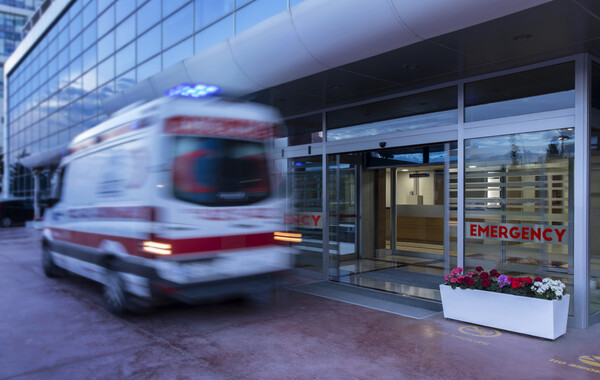Emergency room operations nationwide are in serious disarray.
Some hospitals are closing their ERs at night for nearly half a month. Staff shortages are the cause.
After more than a year of the government-doctor conflict, medical personnel at ERs have long been “burnt out.” Hospitals barely operate ERs with the burnt-out staff. If even one of them “disappears,” hospitals will have no choice but to close their ER.

Sokcho Medical Center has decided to close its emergency room for nearly half a month in February. The public hospital in Gangwon Province will be closed for 13 days this month. The reason for the partial closure is a lack of workforce. The medical center has been operating with five emergency medicine specialists, but two left last month, leaving three.
This is not the first time Sokcho Medical Center has scaled back its emergency department operations. Last July, the hospital had to close its emergency room for seven days due to a lack of manpower when two of the five specialists left. It resumed normal operations in a month, but understaffing remains an issue.
Despite repeated recruitment efforts, no one has applied. The hospital held four recruitment rounds from late December to January but failed to fill the position.
The situation is similar at Chungnam National University Sejong Hospital. Since last month, it has restricted the nighttime operation of its emergency room for adult patients on even and odd days. This month, the emergency room is closed from 6 p.m. on even-numbered days until 8 a.m. the next day. The hospital will keep its Pediatric Specialized Emergency Medical Center open, though.
On a brighter note, Chungbuk National University Hospital will lift the restrictions on adult emergency care and resume normal operations on Wednesday. It has been four months since the restrictions were lifted. The hospital has restricted adult nighttime emergency care every Wednesday since Oct. 2 last year. The reason was also a shortage of workforce and staff burnout amid a protracted medical turmoil.
The hospital decided to normalize emergency room operations following an internal opinion that the medical gap should not be prolonged even with no medical staff recruitment. Its emergency room, which used to be staffed by more than 20 doctors, is now staffed by five emergency medicine specialists. Pediatric critical illnesses were also not adequately supplied by pediatric emergency specialists, but the hospital decided to supplement them as much as possible.
ERs can't function properly at 30 training hospitals
Medical professionals in emergency medicine say there will be more problems in the future.
“Out of 100 training hospitals, 30 are no different from these hospitals,” Lee Hyung-min, chairman of the Korean Emergency Medical Association, told Korea Biomedical Review over the phone. “There are also many cases where patients discharged from the hospital after surgery fall in bad condition but cannot be accepted even if they return to the emergency room.”
The government says there was no emergency medical crisis over the Lunar New Year holiday as the overcrowding of emergency departments with mild cases was eased, but those in the field do not agree.
“We called 70 to 80 emergency rooms for the transfer of some severely ill patients but were told that they were unable to accept them,” Lee said.
He pointed out that understaffed and burnt-out emergency departments cannot provide care to critically ill patients. Faculty turnover and difficulties in providing backup care were also cited as reasons for the failure of transferring patients needing critical care.
Provincial ERs, kept open by 100 returned trainee doctors, also face crisis
Worse yet, the polarization of the emergency room workforce is expected to intensify after March when the transfer of emergency medicine specialists is completed. As manpower flows to the emergency rooms of large hospitals in the Seoul metro region, the provincial emergency rooms will be left with a shrinking workforce.
“February is when 200 to 300 emergency medicine specialists change their workplaces. After March, the manpower gap between hospitals will widen further,” Lee said. “The salary of emergency medicine specialists in large hospitals in the greater Seoul area has risen sharply as the government has subsidized increased medical fees for ER specialists to support the emergency medical system since the outbreak of medical turmoil a year ago. This will inevitably lead to a further shift from regional to metropolitan areas and small to large hospitals."
Lee predicted that the phenomenon of rich-get-richer and poor-get-poorer in hiring emergency medicine specialists would be prominent among hospitals.
“Currently, the emergency rooms of provincial university hospitals are surviving because about 100 resigned emergency medicine trainee doctors have returned. If they leave, regional emergency medicine will become really difficult."
Related articles
- Special incentives fail to bring back resigned junior doctors, with only 2.2% reapplying for medical residency
- Hospital group head calls for increasing medical fees, easing workforce shortage
- Severe trauma fatality rate dropped while disability rate rose over 8 years: KDCA
- Pediatric care in crisis as tertiary hospitals struggle to treat critically ill children
- Mass exodus of professors cripples regional healthcare, leaving patients in crisis
- Regional public hospitals drowning in debt amid prolonged government-doctor conflict
- Physician-turned-politician Ahn calls for resolving government-doctor conflict with dialogue, not pressure
- University hospital professors feel deprived as pay gap with salaried doctors grows
- Government pushes to establish ‘multi-agency cooperative training system’ for junior doctors – amid skepticism
- Emergency medicine doctors’ health in crisis amid ongoing government-medical conflict
- US Embassy warns American travelers as Korea's doctor shortage disrupts emergency care

